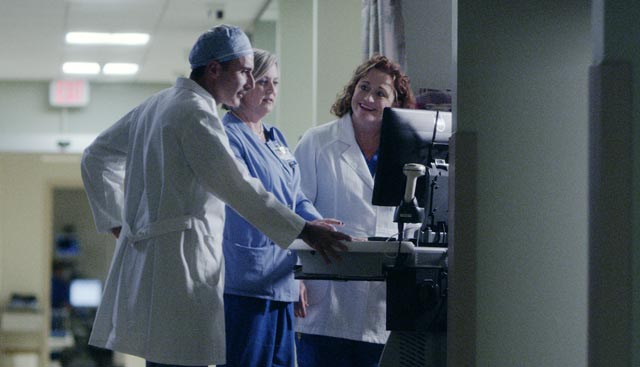Lung Cancer Diagnosis

Lung cancer is a complex malignancy that can involve several tumor types as well as a variety of symptoms. Some people experience persistent coughing, wheezing, shortness of breath and/or chest pain, while others have no symptoms at all. In any case, an early and accurate diagnosis is the key to ensuring the best possible outcome and quality of life.
While smoking is the leading cause of lung cancer, it affects both smokers and nonsmokers alike. Other risk factors include exposure to secondhand smoke, radon gas, asbestos or air pollution.
Is there a screening test for lung cancer?
Currently, the only screening test available for lung cancer is a low-dose computed tomography (LDCT) scan, which can reveal masses and other abnormalities in the lungs. Due to the risks involved—such as false positive results, overdiagnosis and unnecessary radiation exposure—LDCT is not recommended for routine use in individuals who do not have lung cancer symptoms.
According to the latest guidelines established by the National Comprehensive Care Network (NCCN), an LDCT for lung cancer screening is appropriate only for individuals who are:
- 50 or older
- A current or former smoker with a 20-pack-year history
A pack-year is a unit of measurement used to quantify the amount smoked over time. It is calculated by multiplying the number of packs of cigarettes an individual smoked per day by the number of years they smoked. For example, smoking one pack of cigarettes per day for one year is equal to one pack-year, while smoking two packs per day for 10 years is equal to 20 pack-years.
Because there is no general screening test for lung cancer, it is important for everyone to learn about the symptoms and promptly discuss any unusual changes with a physician.
Imaging tests used to diagnose lung cancer
If lung cancer is suspected based on the symptoms or the results of a screening test, the first step in the diagnostic process usually involves imaging tests to provide the physician with a detailed view of the lungs and chest cavity. Some imaging tools that may be used to diagnose lung cancer include:
Chest X-ray
A low dose of radiation is used to create black-and-white images of the lungs, airways, heart, blood vessels and bones in the chest and spine.
Computed tomography (CT) scan
Multiple X-rays are captured from different angles and then combined by a computer to create a three-dimensional, cross-sectional image of the organs and tissues in the chest.
Magnetic resonance imaging (MRI) scan
A powerful magnetic field, radio waves and a computer are used to create detailed images of the structures in the chest.
Positron emission tomography (PET) scan
After a safe amount of a mildly radioactive tracer is injected into the bloodstream, it circulates throughout the body and collects in tissues with high levels of metabolic or biochemical activity. The dye helps to illuminate these tissues in the images captured by a PET scanner.
Follow-up tests used to diagnose lung cancer
If an imaging test reveals a suspicious mass or another abnormality that could indicate lung cancer, the physician will likely order further testing, which may include:
Needle biopsy
Guided by real-time CT imaging, a physician will insert a long, hollow needle into a lung and remove a small sample of suspicious tissue.
Bronchoscopy
A physician will insert a flexible, lighted tube (bronchoscope) into the nose or mouth, guide it into the airways and retrieve a small sample of tissue or fluid.
Sputum cytology
A physician will collect a sample of mucus coughed up from the lungs (sputum).
Endobronchial ultrasound (EBUS)
A physician will insert a bronchoscope with an ultrasound probe at its tip through the mouth and guide it into the airways to obtain images of the surrounding structures, such as lymph nodes. EBUS allows the physician to visualize these structures in real time while collecting tissue samples.
Thoracentesis
After inserting a needle into the space between the lungs and chest wall (pleural space), a physician will drain fluid from the pleural space.
Thoracotomy
After making an incision in the chest wall, a physician will remove a sample of tissue or fluid from the lungs or chest cavity during open chest surgery (thoracotomy).
The biopsied tissue will be sent to a laboratory for microscopic analysis by a pathologist. If the pathologist identifies cancerous cells, further testing may be performed to evaluate the size and extent of the main tumor and determine whether the cancer has spread to nearby lymph nodes or distant organs and tissues. Known as cancer staging, this process will provide valuable information that the physician will consider when evaluating treatment options.

12 diseases that lung cancer is commonly misdiagnosed as
When detected in its earliest stages, lung cancer can often be successfully treated and sometimes even cured. However, time is of the essence. If lung cancer is misdiagnosed or its symptoms go undetected, treatment may be delayed until the tumor has progressed to an advanced stage, which can complicate its treatment.
Many early symptoms of lung cancer can also be caused by other diseases, such as:
- Pneumonia
- Asthma
- Chronic obstructive pulmonary disease (COPD)
- Acid reflux
- Gastroesophageal reflux disease (GERD)
- Encysted lung effusion
- Lung abscesses
- Lung nodules
- Lymphoma
- Thoracic Hodgkin’s disease
- Pulmonary embolism
- Tuberculosis
Because a misdiagnosis of the early symptoms of lung cancer can significantly impact the patient’s outcome and quality of life, it is important to seek prompt medical attention for any unusual changes. It is also important to seek a second opinion if the treatment suggested by a physician for any diagnosis does not promptly alleviate the issue.
Benefit from world-class care at Moffitt Cancer Center
Moffitt is relentless in charting new paths, and we are continually challenging the status quo. Through extensive research, we continue to lead the way in transforming the treatment of lung cancer for all current and future patients. Our team oversees a robust portfolio of clinical trials, and we take a bench-to-bedside approach to quickly transform our discoveries into tangible benefits for our patients. In recognition of our progress made to date, the National Cancer Institute has designated us a Lung Cancer Center of Excellence, and the GO2 Foundation for Lung Cancer has designated us a Lung Cancer Alliance Screening Center of Excellence.
The multispecialty team in Moffitt’s renowned Thoracic Oncology Program offers a full range of the latest screening and diagnostic tests for lung cancer as well as second opinions for patients who have already received a diagnosis. To request an appointment with a specialist on our team, call 1-888-663-3488 or complete our new patient registration form online. We do not require referrals.
References
U.S. Preventive Services Task Force – Lung Cancer Screening
Centers for Disease Control and Prevention – How Is Lung Cancer Diagnosed and Treated?
American Lung Association – How Is Lung Cancer Diagnosed?
